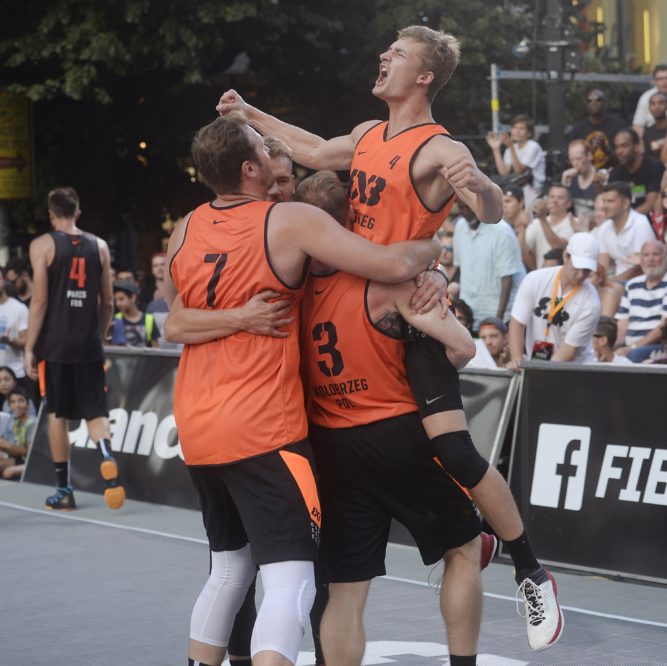
The rumblings were coming for a while but, against stronger odds than you might think, 3×3 basketball will be at the Olympics in Tokyo 2020. Emmet Ryan on why this is a massive coup for international basketball’s governing body and what the status will mean for the condensed form of the sport
The numbers never added up for 3×3. The International Olympic Committee (IOC) has, for several terms now, wanted to contract the Olympics. With costs skyrocketing, even without pockets being lined in some quarters, the ability to find viable host cities is getting tougher. A smaller games was easier to sell to more attractive, particularly in terms of financial end value to the IOC, than the exponential growth the event had been witnessing for decades. There’s a good bit to get through here.
Wrestling’s salvation should have been a problem
The original plan the IOC had was to cut the total number of sports, a move that actually would have worked in FIBA’s favour. Gutting the games the hard way would have presented more wriggle room for the sports that remained so basketball could make a solid case for more than the two events, men’s and women’s conventional hoops, and doubling to four without needing to double the number of athletes would have been quite a strong sell.
That gutting plan was essentially scuppered because one of the sports set for the chop was wrestling and the movement that followed in order to save Olympic wrestling (and rightly so, the Olympics have enough issues without dumping a sport that fires what remains of its soul) led to a change of tact from the IOC. Instead of reducing sports, the goal would be to increase the total number of sports while reducing the number of events per sport. This was about as bad a situation as FIBA could hope for because while 3×3 looks wholly different to basketball for any hoop head, as far as the IOC and its market was concerned this was all under the one sport. Event reduction per sport was terrible news.
The opening
This should have basically killed 3×3 in the Olympics but getting on the programme of events like the European Games, while major sports bodies like FINA and the IAAF weren’t playing ball with the IOC due to their backing of the rival European Championships (yes these are a thing) was a big boost for its case. It also was part of a recipe of factors that led to another change in strategy from the IOC which, frankly, even I was unaware of before the announcement on Friday.
Shave not slash
The IOC had backed out of gutting entire sports but now, from the information available, it’s also moving away from cutting events per sport en masse. Instead the number of athletes per event is going to get shaved, with new events coming in for sports like athletics (mixed 4x400m relay) which looked like they might see some kind of a chop. The IOC moving towards increasing the number of events while keeping athlete numbers down was exactly what FIBA needed to get 3×3 through. When you’ve got a TV friendly, particularly in terms of highlights, sport that just looks cool it’s going to be much easier to sell without the slashing plan that appeared to be in place.
What we’re going to see
With the IOC confirming the 3×3 tournmanent will see a total of 64 athletes, split evenly 32 each for men’s and women’s tournaments. In terms of athlete count, that’s actually pretty good since the IOC has managed to cut the number of total athletes across all sports at Tokyo 2020 by 285. With no impact on normal basketball, which has 288, that’s a big win for basketball.
It does however mean that we can expect pretty compact tournaments all the same. One of the recurring complaints, from both fans and FIBA, about the current basketball tournament in the Olympics is that its restricted to 12 teams in each tournament. This will be the same with 8 rosters of 4 players each for the men’s and the same for the women’s.
In terms of format this could go a couple of ways. The duller but more equitable option is 2 groups of 4 teams with the top 2 in each progressing. Based on what we’ve seen with the European Games however the more likely and TV friendly version will see 2 groups of 4 play on one day, with all 8 teams progressing to the knockout stages on a seed basis. There has been nothing in the communications from FIBA or the IOC indicating which approach they will use but I’d be shocked if they don’t go with the latter option.
The image boost
One of the reasons the IOC likes basketball is that is that it’s seen as cool. One of the big contributing factors to this has been the US national sides, especially the men with the NBA star power. The problem is that, more often than not, the run to gold feels like a procession for the US in both men’s and women’s events.
Having another event where observers are, by and large, unfamiliar with the players but the action is fast and exciting will help. There will be obvious favourites to regular observers but enough doubt and not the same sense of inevitability. The streetball feel to it will also help with the cool factor, which as a middle aged grey white dude I probably am the least qualified to quantify.
Strategic timing
It’s not an accident that the announcement was made with just over a week to go before the 3×3 World Cup in Nantes. Getting on the Olympic programme is a boost for any country’s governing body that’s already investing in the sport or those looking to accelerate interest. Simply having the shot of getting to the biggest show helps when it comes to seeking government support and, now, the sport gets added to the Olympic programme a short while before its showcase event.
All pictures courtesy of FIBA 3×3





